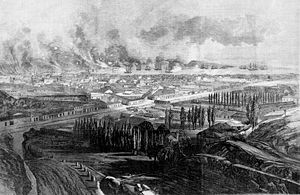Bombardment of Valparaíso
Battle between Spain and Chile on the coast of Valparaíso From Wikipedia, the free encyclopedia
The Bombardment of Valparaíso on 31 March 1866 took place during the Chincha Islands War, when a Spanish fleet shelled, burned and destroyed the undefended port of Valparaíso.
| Bombardment of Valparaíso | |||||||
|---|---|---|---|---|---|---|---|
| Part of Chincha Islands War | |||||||
 The Spanish fleet shelling the port of Valparaíso | |||||||
| |||||||
| Belligerents | |||||||
| Spain | Chile | ||||||
| Commanders and leaders | |||||||
| Casto Méndez Núñez | N/A | ||||||
| Strength | |||||||
|
1 ironclad 5 frigates 1 corvette | N/A[1] | ||||||
| Casualties and losses | |||||||
| None |
2 killed 10 wounded 33 ships sunk | ||||||
Background
Summarize
Perspective
After the humiliating defeat at the Battle of Papudo and the indecisive Battle of Abtao, Rear Admiral Casto Méndez Núñez was ordered to take punitive action against South American ports. When the Chilean government ordered that vessels supplying or communicating with the Spanish fleet should not be allowed to enter Chilean ports, Méndez Núñez's first target became the most important and undefended Chilean city of Valparaíso.[2]
Attempts at mediation
Efforts to mediate were initially steered by European diplomats whose countrymen were most affected by the initial blockade of Chilean ports and by the threat of bombardment. High-level contacts took place intensively in late 1865 and early 1866 between London, Paris, and Madrid. A formula to resolve the conflict appeared, at one stage, to have been secured. In the final two weeks, the United States was especially active. The American minister to Chile, General Hugh Judson Kilpatrick and the U.S. naval commander John Rodgers, who was at port commanding a United States Navy squadron composed of the ironclad monitor USS Monadnock and the warships Powhatan, Tuscarora, and Vanderbilt, attempted a last-minute settlement with the Spanish admiral. To that effect they enlisted the cooperation of the commander of the British Pacific Station, Rear Admiral Joseph Denman, who had under his command two warships: HMS Sutlej and HMS Leander. The British commander, despite coming under great pressure from British merchants in the city, after consulting with the chief British diplomat in Chile William Taylour Thomson, decided to enforce strict neutrality, refusing to let his ships cooperate. Thomson himself was more concerned with the well-being of Spanish civilians in Chile than with the concerns of the British merchants in Chile and did not want the Royal Navy to do anything to provoke the Spanish. [3]
Ultimately, all the attempts at mediation failed, as the chief condition of Admiral Méndez Núñez was the proper salute to the Spanish flag, the return by the Chileans of the captured schooner Covadonga and the immediate payment of a crippling indemnity. The talks broke over the matter of the flag salute.[4] When General Kilpatrick threatened to defend the port with the US squadron and attack the Spanish fleet, Admiral Méndez Núñez famously responded with, "I will be forced to sink [the US ships], because even if I have one ship left I will proceed with the bombardment. Spain, the Queen and I prefer honor without ships than ships without honor." Consequently the Spanish Admiral, notwithstanding the protest of the diplomatic corps, gave notice on March 27 to all neutrals to evacuate the city.[4]
Bombardment
Summarize
Perspective
At 7 am on March 31, the Spanish fleet took positions in front of their targets. It consisted of Numancia, Resolución, Villa de Madrid, Reina Blanca, Vencedora, and Paquete de Maule. The frigate Berenguela remained behind to guard against the possible escape of the merchant fleet. At 8.10 AM, the Numancia discharged two shots as final notice and to give opportunity for the people still in town to take cover. The bombardment itself started at 9 am and lasted for three hours without fire being returned, as Valparaíso was totally defenseless.[4]
The Spanish bombarded the town unhindered.[5] The loss in public and private property was estimated at $1,000,000, and in merchandise at $9,000,000, huge sums at the time.[6] A 2011 account suggests that in that year's money the losses amounted to the equivalent of around $224,000,000.[7]
The action created an international scandal.[7] While the Spanish were heavily criticized for attacking an unarmed city, so too was the British government for not employing its own naval force to protect the lives and property of its own nationals. Most of the losses were actually endured by British merchants, and a large argument developed in the British Parliament when news arrived in May 1866.[8]
Painting

James McNeill Whistler, who was on board the American ships, painted his famous "Nocturne in Blue and Gold: Valparaíso Bay" the night before the bombardment. It shows the Chilean merchant fleet at its moorings where it would be destroyed the next morning.
Notes
Sources
External links
Wikiwand - on
Seamless Wikipedia browsing. On steroids.
